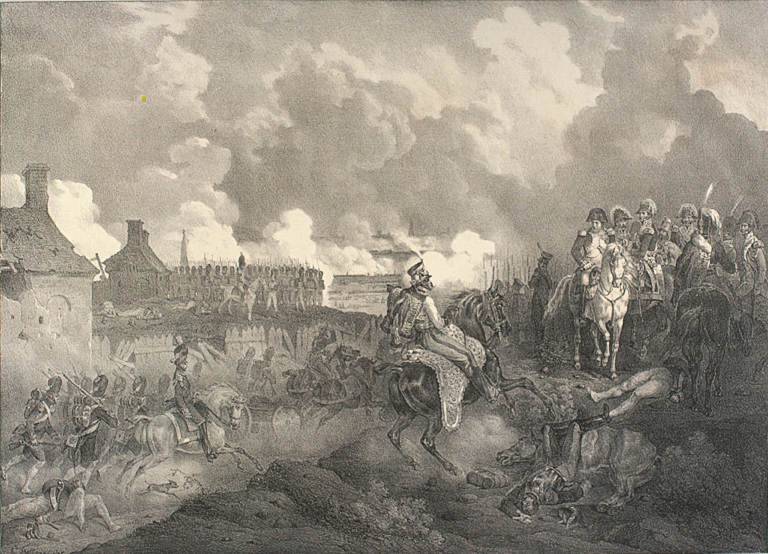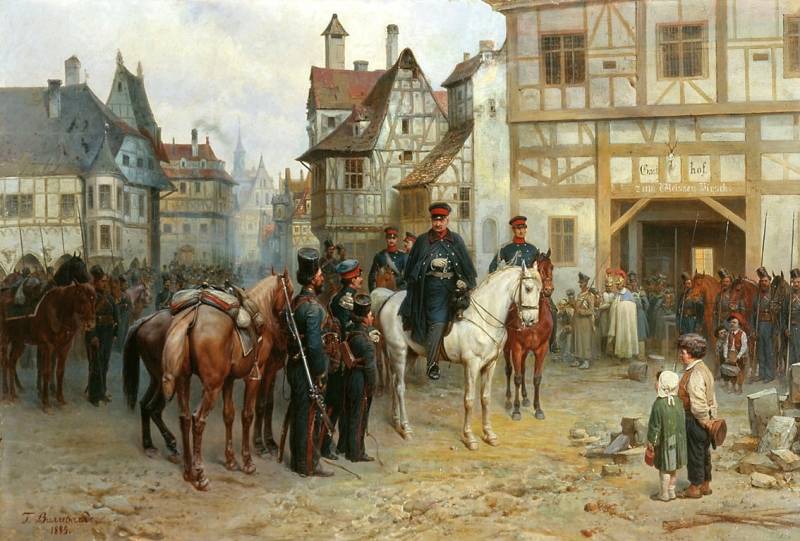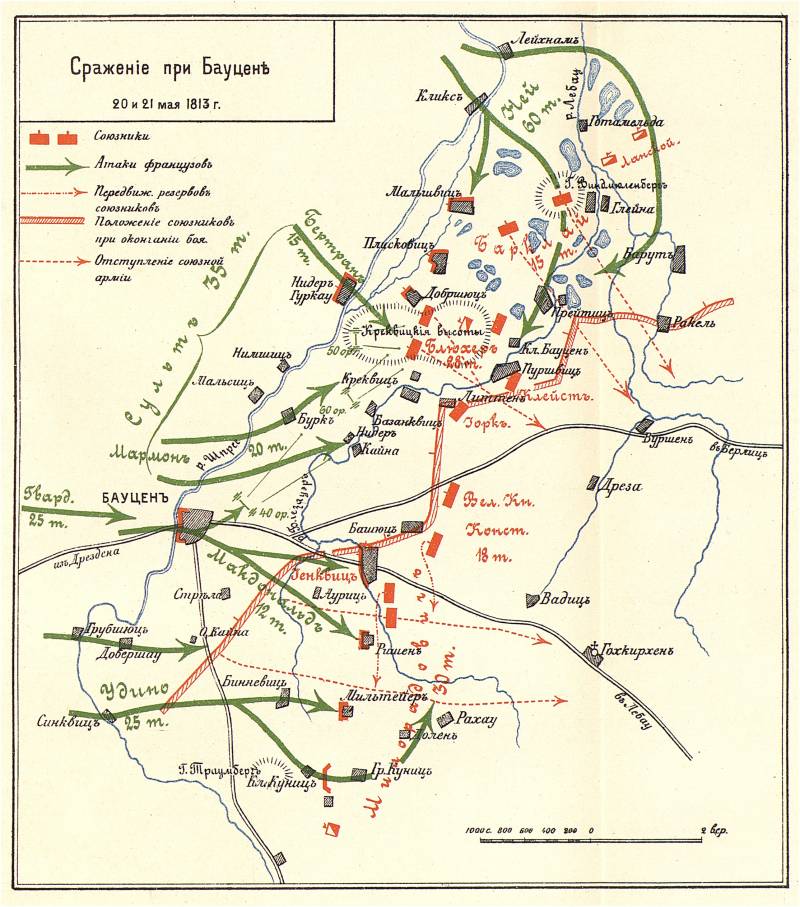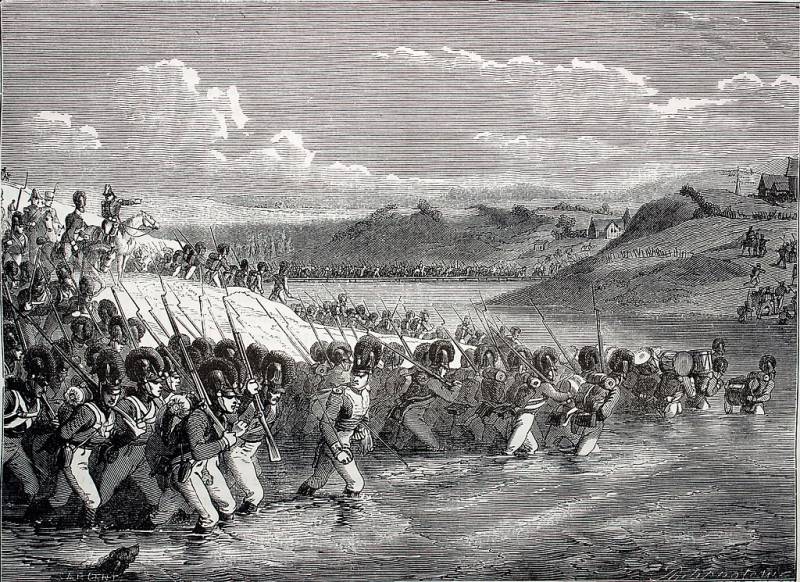"Such a massacre and no results!" Battle of Bautzen

Napoleon watches the assault on Bautzen. XNUMXth century drawing after the painting by I. Bellanger
General situation
After the defeat at Lützen (The defeat of the Russian-Prussian army at Lützen) the Russian-Prussian army left Leipzig and Dresden, withdrew beyond the Elbe. The retreat was successfully covered by the rearguard under the command of Miloradovich. Saxony was again under the rule of Napoleon. The allied command abandoned their offensive plans, decided to slowly retreat, hold back the enemy and wait for the Austrian Empire to enter the war. Vienna promised to soon take the side of Russia and Prussia. At the same time, they were not going to refuse a new general battle under favorable circumstances.
Napoleon, due to the lack of cavalry, could not launch a quick offensive and impose a fight on his own terms. But he strengthened his military-political position in Germany. The territory on the left side of the Elbe was under the complete control of Napoleon. The monarchs of a number of German states held secret negotiations with the allies, but did not dare to openly oppose the French. Thus, the Saxon king Friedrich-August owed Napoleon a significant expansion of his possessions and, in the event of an Allied victory, could lose the Prussian territories that he received under the Tilsit agreement.
Before Lützen, the Saxon monarch tried to maneuver, to maintain neutrality. He fled to Austria. Part of the Saxon army accompanied the king, the other settled in Torgau. But after Lützen, Napoleon demanded that Frederick-August return to Dresden, open the gates of Torgau and join the French army. Otherwise, the French emperor promised to deprive Frederick-August of the throne and possessions. The Austrian monarch was forced to accept these conditions.
The Austrians waited. They negotiated with both the Allies and the French. On May 12, the Austrian diplomat Count Stadion arrived at the Headquarters (headquarters) of Tsar Alexander I, who assured that Vienna would join the Russian-Prussian alliance at the end of the month. At the same time, the Austrian General Bubn was sent to Dresden to Napoleon with a letter from the Austrian Emperor Franz, which offered mediation in the negotiations. The Vienna court assured Bonaparte of their devotion and peaceful plans. The Austrians also hinted that they would like to receive from Italy - Illyria, expand the territory in Poland and Bavaria, and destroy the Confederation of the Rhine, which threatened the influence of Vienna in Germany.
In negotiations with the Austrians, Bonaparte agreed to convene a congress to conclude a truce. A letter about this was sent to the Allied Headquarters on May 6 (18), 1813. On the same day, Napoleon set out with the guards from Dresden along the Bautzen road. The Allies did not give any answer to this proposal.

B. P. Villevalde. Blucher and Cossacks in Bautzen
Battle of Königswart and Weisig
The allied command, having received news of the movement of the enemy’s vanguard (the corps of Lauriston, followed by the corps of Ney), sent the corps of Barclay de Tolly, the grenadier corps of Raevsky and the Prussian corps of York against him, in total about 24 thousand people under the general command of Barclay. On May 7 (19), Barclay's troops completely defeated the 7th Italian division of General Peyri at Königswarta. 7 guns were captured, 2 were damaged, the entire convoy, division general Peyri, three brigadier generals and 754 officers and soldiers were captured.
At the same time, York's corps (5,7 thousand people) entered into battle with the enemy at Weissig. By evening, a stubborn battle ensued on the heights of Eichberg, which were the key to the position. Height changed hands several times. However, the French had a great advantage in strength, and York, fearing encirclement, began to withdraw troops. The Prussian corps in this battle gained great fame, holding back the onslaught of a three times stronger enemy for six hours and losing a third of its composition. York, along with Russian reinforcements, had about 8 thousand soldiers, but they fought so bravely that Lauriston reported that there were more than 30 thousand enemy soldiers against him.
On May 8 (20), Barclay's troops returned to the Bautzen positions. The Prussian troops lost 1,8 thousand people, the Russians about 1 thousand. French losses are unknown. An Italian division was destroyed.
Opponent forces and their plans
The losses of the allied army after the defeat at Lützen were made up for by the approach of Barclay's 13-thousand corps, which was released after the capture of Thorn. Kleist's detachment also arrived, along with Prussian and Russian reinforcements. The size of the allied army reached 93 thousand people (65 thousand Russians, 28 thousand Prussians) with 610 guns. Of these, about 24 thousand cavalry, including 7 thousand Cossacks.
The position of the Russian-Prussian army at Bautzen consisted of two lines. The first defensive line ran along the right bank of the Spree river across the main road, in the center of it was the city of Bautzen, which was protected by a stone wall. The city was prepared for defense, additional fortifications were erected in it. The forward position was defended by parts of General Miloradovich.
The main position was not continuous and was located on the heights behind Bautzen, stretching for 12 km. The left wing (southern) was covered by a mountain range, behind it was the Austrian territory, on the right wing (northern) the advance was hampered by many swamps and ravines. On the left wing was the Russian corps under the command of Gorchakov, in the center - the Prussian corps of Johann York and Gebhard Blucher, on the right wing - the corps of Barclay de Tolly. The Russian guard was in reserve.
The monarchs Alexander I and Friedrich Wilhelm III, despite the noticeable numerical advantage of the enemy and the reasonable advice of Barclay de Tolly not to accept the battle and retreat, insisted on the battle. The commander of the Russian-Prussian army, Wittgenstein, in contrast to the battle of Lützen, where the initiative was initially on the side of the allies, chose a purely defensive tactic, deciding to use the difficult terrain. Wittgenstein understood that the enemy would bring down the main attack on his right flank, but his opinion was not taken into account. As under Lützen, the commander-in-chief did not have full power in the army.
Napoleon had a great superiority in strength: 143 thousand soldiers. However, the French were still weaker in cavalry (12 thousand people) and artillery (350 guns). Directly at Bautzen, the emperor had about 100 thousand soldiers - 4 infantry corps and a guard. Three more Ney corps approached from the north, about 45 thousand people, which were originally aimed at Berlin. Ney approached the second day of the battle.
On the right flank, the 12 Corps of Oudinot (20 thousand people), the 11 Corps of Macdonald (12 thousand) advanced in front of Bautzen, on the left flank - the 6 Corps of Marmont (20 thousand), the 4 Corps of Bertrand (20 thousand). 15 thousand guardsmen were in reserve. Soult commanded the left wing, Oudinot the right. Napoleon was going to inflict powerful blows on the center and left flank of the enemy, tie up the enemy and take him out and throw reserves into battle. Ney's corps (3rd, 5th and 7th) were sent to bypass the right flank of the enemy in order to go to the rear and press the enemy against the mountains. A decisive victory made it possible to force the allies to peace.

Battle
On May 8 (20), 1813 at 10 o'clock in the morning, MacDonald's corps launched an assault on Bautzen, and the troops under the command of Soult and Oudinot launched an attack on the heights along the forward position of the allied forces on the Spree. After 3 p.m., French troops were able to cross the river in several places. By 6 pm, the right wing troops of the allies withdrew to the main position. The French also captured Bautzen, after which they attacked the left wing of the Russian advanced position without much success.
A particularly fierce battle unfolded over the heights on the extreme right flank, where 5 Kleist Prussians fought 20 French from Bertrand's corps. Kleist, having received reinforcements, repulsed the frontal attacks of the enemy, but by 8 o'clock also withdrew to the main positions (Marmont's troops bypassed him). In the evening, Ney's troops came into contact with the advanced units of Barclay de Tolly on the far right flank. The battle was over by 10 pm.
On May 21, at 5 o'clock in the morning, the corps of MacDonald and Oudinot attacked the left flank of the allies. Alexander I, despite Wittgenstein's warning, ordered the transfer of most of the reserves to the left wing. Miloradovich, having received reinforcements, counterattacked and by 2 o'clock in the afternoon recaptured the previously lost positions.
On the right flank at 6 o'clock in the morning, Ney's corps began to attack the position of Barclay's troops. The French were aimed at the village of Gohkirchen, after the capture of which all the escape routes of the allied troops would have been cut. Barclay had 12 soldiers against 45 French. But he had an advantage in artillery and a strong position (he occupied heights, the enemy had to go through very rough terrain). Ney sent two divisions from Lauriston's corps to outflank the enemy positions. By 11 o'clock in the morning, Barclay withdrew troops to a new position across the Lebau River, which opened the flank of Blucher's neighboring Prussian corps. With a joint counterattack, the Prussian and Russian troops drove the French out of the town of Preititz and stabilized the situation.
Napoleon, having received news of Ney's difficulties, ordered a strong attack in the center. The French pressed the Prussians. Having received reinforcements from the Russians, the Prussians counterattacked, trying to restore their former position. By 2 o'clock in the afternoon, Preititz again occupied Ney, and Bonaparte threw reserves into battle - the guards and the artillery reserve. Ney's troops were unable to break through to Gorkirchen, bogged down in battles with the Prussians of Blucher. Carried away by private battles, Ney did not complete the main task, this saved the allies from disaster.
The allied command realized that the continuation of the battle threatens the enemy with an exit to the rear of the army, loss of communications and complete defeat. The defense in the center, at the junction of the center with the right flank, was weakened, only on the left wing Miloradovich retained his position. At 4 p.m. the army began to leave in three columns. At first, under the cover of the rearguards, Blucher retreated, then Barclay's troops closed the retreat of Miloradovich's left flank.

Results
The allied army suffered a second defeat in a general battle with the French. However, Napoleon could not achieve decisive success, completely defeat the enemy. The allies themselves made the decision to withdraw, they retreated in perfect order, the army retained its combat effectiveness and morale, artillery and carts. The double superiority of the Russian-Prussian troops in the cavalry did not allow the French to use the victory, intercept and finish off the enemy. It is not surprising that Napoleon exclaimed after the battle:
The allied army lost 12 thousand people: 6,4 thousand Russians and 5,6 thousand Prussians. French losses were heavier - 18-20 thousand people, the superiority of the allies in artillery and the terrain convenient for defense affected.
For Prussia, this defeat was a serious political blow, as the fighting was transferred to its territory. The allied army withdrew to Silesia.
Sovereign Alexander I, annoyed by the second defeat in a row, replaced the commander-in-chief Peter Wittgenstein with the more experienced and senior in seniority in the rank of Michael Barclay de Tolly.
Both sides, without achieving decisive success, agreed to a truce. On May 25, negotiations resumed at the initiative of the French. On June 4, 1813, Napoleon concluded an armistice with the Allies at Pleiswitz until July 20 (then extended until August 10), after which he returned to Dresden. Both sides hoped to use the respite to mobilize forces.
Many historians and Napoleon himself would later call this truce a serious strategic miscalculation by the French emperor. During the armistice, Napoleon's opponents significantly strengthened their ranks. Sweden joined the anti-French coalition, and the Habsburg Empire opposed France.
- Alexander Samsonov
- https://ru.wikipedia.org/
Information